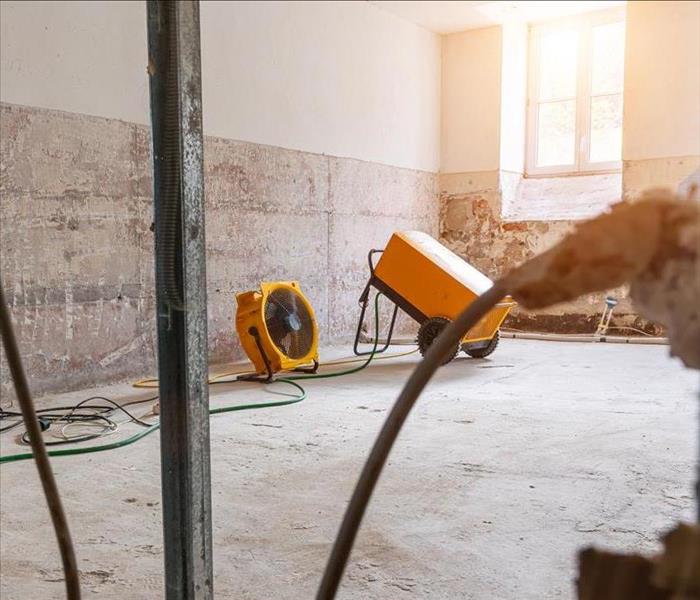Water Damage Restoration Tips: Prevention and Restoration
10/13/2022 (Permalink)
Every state in the United States has experienced some type of flooding within the past six years. And with flooding, comes water damage. Even if you do not live near a body of water, you may still be at risk for facing water damage. Water damage can be hazardous and costly.
Natural causes of water damage include: thunderstorms, hurricanes, heavy rain, even snow melting hundreds of miles away, which makes the flood waters rise. Broken pipes, damaged appliances, sprinkler system issues, sewer line backups, and overflowing tubs and sinks can also lead to water damage. And water damage or the threat of water damages is not to be taken lightly. When water damage occurs, time is of the essence.
Water Damage Prevention Tips
The best thing you can do is have a prevention plan in place for water damage. When water damage occurs, a homeowner must act fast. Prepare yourself now and avoid major damage later.
- Know the sources of water both inside and outside of your building.
- Sources of Interior Water: plumbing, piping, drains, fire sprinklers (piping and sprinkler heads), shower, bath, laundry, condensation sources, pool/spa plumbing and pumps, mechanical systems (evaporators and piping), etc.
- Sources of Exterior Water: neighboring properties, city water supply, exterior plumbing, foundations, groundwater, irrigation systems, roofs and roof drains, septic systems, windows and doors, siding, waterproofing, etc.
- Ensure good water runoff. Clean your gutters and inspect downspouts to ensure they are pointed in the correct direction and working properly.
- Know the location of the stopcock. Ensure family members know where and how to shut off the water supply. Severe damage can occur within minutes of a leak so it is essential to act quickly.
- Periodically and proactively check for leaks. Check under sinks and around appliances such as dishwashers and washing machines. Even minor leaks can cause major water damage if left unattended. For example, a leaky tap can leak up to 57 gallons of water per week.
- Keep gutters clear of debris. Ensure gutters are not blocked or sagging. If either is occurring, clean and repair gutters promptly.
- Inspect your roof on the inside and outside. Check attic for leaking water. Look for discoloration on ceiling. Check the roof exterior for visible damage.
- Pipes, pipes, pipes… If a property will be unoccupied for an extended period of time, turn off the water supply at the stopcock. You may wish to consider draining the system so no water is left in the pipes. In colder climates, use a smart thermostat to maintain a minimum temperature in your home to prevent pipes from freezing. Properly insulate exposed pipes.
- Use a water leak detection device. These devices turn off the water supply should you have a leak. This is especially useful if your property will be vacant for an extended period of time.
- Check for moisture and mold. Flaky paint or wallpaper is a sign of dampness. Be on alert for musty smells and cold walls. This may indicate the need for additional insulation. Look for window and skylight condensation in the mornings. This may mean elevated levels of moisture.
Water Damage Restoration Tips
When water damage occurs, it is imperative that you act quickly. Use the following water damage restoration tips as soon as you notice signs of water damage.
- Immediately disconnect outlets. Upon noticing water damage, unplug all electronics immediately. Even if you do not yet see the severity of damage, be cautious around appliances and gas lines. Failure to unplug electronics could lead to electrical shocks and explosions.
- Eliminate all water and moisture. Use dehumidifiers and water pumps to remove moisture from the air and water from the ground. Stimulate air circulation in the room through the use of air movers, portable ventilators, and open windows. Try to make the room breezy and dry.
- Look for mold. After you have removed the water and moisture, notice the smell. If indoor air smells musty, you may have a mold or mildew problem. Sometimes, household cleaning products will remove the mold. However, mold can spread quickly, often requiring a mold specialist. Do not attempt to fix major mold problems on your own. Mold can lead to serious health problems.
- Remove the damaged materials. Immediately dispose of porous water-soaked materials, such as insulation or carpet, to avoid mildew. Focus on the ceiling and the floors first. Unsealed structural materials, such as unsealed cement, drywall, and wood, should be replaced to support water damage restoration efforts. Water can make the structure of your building unsafe, so it is essential to focus on replacing structural materials first.
- Disinfect all of the remaining areas. Water can contain bacteria and other hazards that are damaging to your health. Once your remove the water and damaged materials, disinfect the entire area before beginning the water damage restoration process. Bacteria can be invisible. Use bleach to wipe surfaces so the mold spores do not continue to grow. The goal is to eliminate any possible bacteria present.
Water Damage Repair with SERVPRO of Wellington South
The water damage restoration process can be tiresome and stressful. Take one step at a time and act quickly. Use safety precautions to avoid harming yourself and your loved ones. Remember, it is possible to return your property to its previous condition. Enlist the help of professionals when needed.
SERVPRO of Wellington South is your go-to water damage restoration company. Please contact us today to assess your water damage and make it “Like it never even happened.”

 24/7 Emergency Service
24/7 Emergency Service
